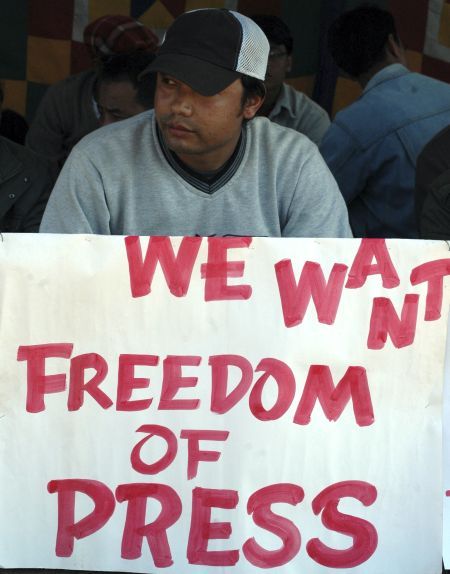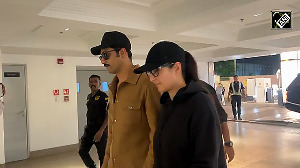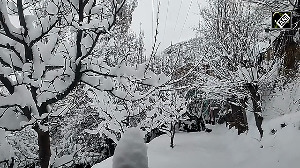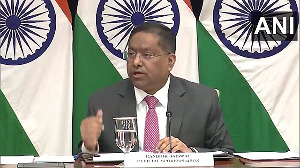 'The media today is completely free from the government-induced fear factor.'
'The media today is completely free from the government-induced fear factor.'
'It is only scared of the public backlash and its TRP ratings,' say Sudhir Bisht.
Something important happened last month which should have normally gladdened the hearts of all media men and women.
The Supreme Court nudged the Rajasthan government to look into the concerns raised by the Rajasthan Patrika, the leading Hindi daily in the state, on the declining advertisement revenue it earned from the state government's overall kitty of advertisement expense.
People would have laughed at Rajasthan Patrika if it had approached the Supreme Court bench with a plea that Hindustan Unilever Limited had stopped advertising its Rin, Surf Excel and Kissan jam in the Patrika.
HUL is a private corporation and it can choose to publish its ads in any newspaper it wants. If HUL wants, it can choose to draw a blank on Patrika and publish all its ads in Dainik Bhaskar.
But the Rajasthan government is not a corporate entity. It is supposed to distribute the ads, which are paid for by the people's money, in a manner that is fair and transparent. It is well known that stopping press ads in a publication amounts to indirect censorship.
The newspaper publisher, through its lawyer Abhishek Manu Singhvi, pleaded that the government's advertisements to the Patrika was almost negligible in 2016. During previous state government regimes, the Patrika used to get a minimum of 35 per cent of all advertisements released by the state government.
The moot point here is that the newspaper groups today have so much support that they are able to ensure that the governments in power don't allocate advertisement expenditure arbitrarily. Thanks to the judiciary for the role that it is playing to ensure that.
The Government of India, one of the largest advertisers in the country, is bound by so many shackles. It can't just stop the supply of oxygen of advertising arbitrarily and asphyxiate a newspaper.
That the Government of India exercises no control over newspapers is reflected in the fact that advertisement support to newspapers that have a pronounced anti-National Democratic Alliance bias like the Indian Express and the Hindustan Times hasn't diminished at all.
Neither has their electricity been cut off nor are their tax returns being scrutinised as it happened during the Emergency.
Some time ago, when the NDA completed 100 days in power, I casually switched on my television set and after some channel surfing, I stopped at a programme with a lady anchor.
She was clearly giving inordinately more time to those who were putting forth anti-government (read anti-NDA) points of view. She was cutting off mid-way those speaking in favour of the government.
On the other hand, even though the government's critics were leaving no stone unturned to run down the NDA, the anchor too joined them in painting the government just short of being a villain.
What makes all of this interesting is the fact is that programme was shown on the government-owned Rajya Sabha TV.
Now I know that the RSTV CEO reports to the Rajya Sabha where the NDA is in a minority, but the fact is that RSTV is an almost nil revenue generating television channel which depends on government funding to sustain itself.
The point I am trying to make here is that the media in Narendra Modi's regime is free from any direct or indirect interference from the Union government or its agencies.
In the electronic media segment, Times Now seems to have taken a pronounced pro-NDA tilt whereas its print media arm continues to remain Left-of-Centre.
Recently there was an internal communication from the nation's biggest media house which stated that the group did not have a centralised editorial policy and each publication or media entity in the group had its own independent editorial policy.
This seems to make perfect business sense with the popular electronic media arm backing the NDA and the print arm playing the balancing game.
And if NDTV, arguably the second biggest electronic channel, has been trying to shed the image of being an extended arm of the Congress party, it has more to do with the realisation dawning upon it that its core viewership would desert it if it continued to attack the NDA.
The recent no-show of P Chidambaram's interview, where he is believed to have shown some scepticism on the surgical strikes, has nothing to do with any kind of government pressure on the television channel.
It is due to the owner's perception that the former home minister's narrative may be completely against the mood of the nation and it also could be a slanted narrative against the government which seems to have the complete backing of most citizens, at least as of now.
From the above examples, I have attempted to establish the case that the media in India is free from any pressure from the government.
In fact the media hasn't been more free than it is now.
The 'government-is-intolerant' brigade may keep raising their slogans, but it doesn't gel with the reality.
Until recently, before the mood of the nation became ultra-nationalistic, most channels were criticising the Modi government for anything and everything.
Except for Times Now, India TV and Zee News, which have developed a pro-NDA bias, every other channel had its poster boys and girls whose only job was to criticise whatever Modi did.
Rajdeep Sardesai, Barkha Dutt, Bhupendra Chaubey, Nidhi Razdan criticised the Modi government for almost everything. But did they face any discomfort in doing their job? Not at all.
I am not questioning their right to criticise or question Modi, but their criticism seemed to follow the beaten track.
If Modi pushed for GST, why did he oppose it when he was in the Opposition?
If the government continued with the Aadhar card, why did he oppose it earlier?
If MNREGA wasn't abolished, why not?
If Modi was being friendly with Pakistan, why was he mocking Manmohan Singh for his pro-peace policy?
If Modi was concentrating on foreign affairs, why was he spending so much time abroad?
If Modi was silent on stray incidents of attacks on the minorities, why was he silent?
If Modi spoke about his deep sadness at the attacks on Dalits, why did he speak so late??
The list goes on and on. Why was Modi not doing anything to prove his bravery claims after the Pathankot and Uri attacks? But before these media pundits could start asking, 'Why did Modi go for surgical strikes?', the mood of the nation had changed.
It suddenly was not acceptable to criticise your country at a time when the enemy nation was being subjected to tough retaliatory action. It was no longer acceptable to ask for proof of surgical strikes.
The media pundits did try to change their tactics. They started the narrative that such strikes/operations were routine in the past and that the chest-thumping for routine strikes was the sin that Modi was committing.
But this narrative had no takers and the media pundits started to backtrack. The credibility of these channels started to become suspect.
So the media has not fallen like nine pins, as Chidambaram seems to suggest. The media pundits have fallen in line with the truth.
The media today is completely free from the government-induced fear factor. It is only scared of the public backlash and its TRP ratings.
Sudhir Bisht, author and columnist, tweets at @sudhir_bisht











 © 2025
© 2025